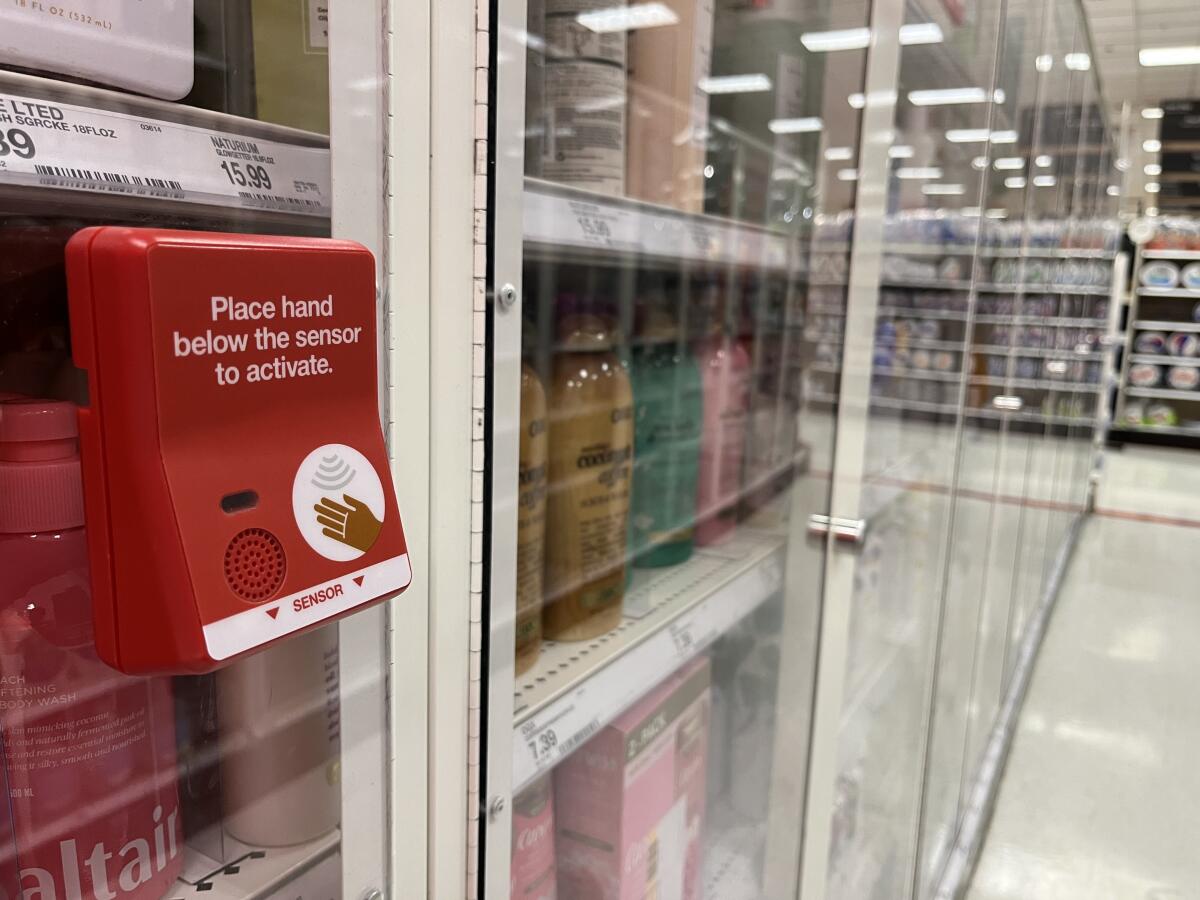What we know (and don’t) about the rise in retail theft

Good morning. It’s Wednesday, Oct. 18. Here’s what you need to know to start your day.
- What we know (and don’t) about the rise in retail theft
- The House failed to elect Jim Jordan as its next speaker
- What to know before heading to California’s popular ski resorts
- And here’s today’s e-newspaper
Sign up for Essential California
The most important California stories and recommendations in your inbox every morning.
You may occasionally receive promotional content from the Los Angeles Times.
Putting California’s rising retail theft in context
Shopping in person feels different these days. I first noticed a shift at my local grocery store, where some hygienic products were cordoned off by plexiglass. An employee now monitors the zone and a man dressed like a Call of Duty character patrols the store exits, with a gun strapped to his side.
At my local Target, I found laundry detergent, body wash and other personal care items locked behind security glass. I had to call a worker several times to unlock and relock shelves of products I used to just put in my shopping bag with ease.
Watch the news or scan social media for five minutes and you’ll understand what’s driving that unsettling shift. We’ve all seen the videos of store robberies as groups of people stuff bags with high-end merchandise and walk out the front door. In some cases, those team-effort crimes are part of an organized network of thieves who then sell the stolen items. That’s referred to as organized retail crime.
It’s not just retailers reacting: Gov. Gavin Newsom announced in August that the state would triple the California Highway Patrol’s resources in the city of Los Angeles to address the issue. The CHP operates an Organized Retail Crime Task Force, which has investigated roughly 1,850 retail crimes statewide since its formation in 2019.
Also in August, L.A. Mayor Karen Bass announced a new regional task force had been created to “aggressively investigate these incidents and hold individuals that are responsible for these crimes fully accountable.”
But just how pervasive is this crime trend? I spoke with some California crime and policy experts to understand what the data show (and don’t show) and how the perception of these crimes is affecting Californians.
Retail theft has increased, but the data are murky
Magnus Lofstrom is director of criminal justice at the Public Policy Institute of California. He and his team recently analyzed the available data on retail theft in the state’s 15 most populous counties.
Part of the challenge in tracking these crimes is that retail theft can fall under several different crime categories, depending on the value of the items taken and whether force was used or threatened during the crime.
What the data do show is that overall felony retail theft was up 16% in 2022 compared with 2019. A closer look showed commercial burglary specifically was up 13%. Commercial robbery, which includes thefts in which force is used or threatened (like some smash-and-grab thefts), was up about 13% in that same time frame.
And when it comes to misdemeanor shoplifting, the data show a 29% spike in 2022 vs. 2019, though the PPIC report notes that the rate for that crime remains 8% below its pre-pandemic level.
Researchers found that both commercial burglary and robbery rates had increased notably in the San Francisco Bay Area and Central Valley counties, but that Los Angeles County experienced the highest commercial robbery rate in 2022.
Overall? Commercial burglary reached its highest rate since 2008, “and the commercial robbery rate rose to roughly where it was in 2017,” Longstrom and fellow PPIC researcher Brandon Martin wrote in a blog post.
Lofstrom told me that although state crime data can show the overall trend of retail theft, “we cannot separately identify if a particular incident was driven by organized retail theft.” He also noted that it’s difficult to paint in broad, statewide strokes when it comes to crime.
“Crime tends to be local, so we can see some increases in one particular area and not see it in other areas,” he said. “It’s very difficult to tease out exactly what’s behind these [trends] — and especially in these rapidly changing and challenging times.”
The media’s role in shaping perceptions
Yes, retail theft is up in California and elsewhere in the U.S. But those increases come even as overall crime rates have decreased notably from the rates experienced in the 1990s.
How the media frames and covers crime can have a strong impact on the perception of how safe we are. And with the prevalence of video monitoring in public spaces — both surveillance technology and our cameras that double as phones — it’s never been easier to record and share video of people behaving badly.
In L.A. for example, violent crime and some types of property crime have fallen over the last year. Despite that, there’s a “disconnect between statistics and public perception” of safety, my colleague Libor Jany wrote this week.
“Some research suggests that part of the problem is a feedback loop in which people have a tendency to focus on and remember negative information [about] crime or the economy,” he reported. “Even though crime has been trending downward for more than a quarter of a century, in nearly every year since 1996 Gallup poll respondents have said they felt less safe than the year before.”
Simply put, when the news media regularly fills broadcasts or social feeds with visuals of criminal chaos, they’re sending a signal to the public: this is what you should be concerned about.
As Charis Kubrin, a professor of criminology law and society at UC Irvine, witnessed firsthand recently, it’s difficult to shift gears to nuanced dialogue about crime after the emotional reaction of seeing violence, brazen thefts and other misdeeds. The spectacle of watching crime tends to trump a lesson on crime statistics.
She described a recent appearance on MSNBC during which she aimed to offer perspective rooted in the available data as footage of a recent smash-and-grab robbery played during her interview. She said she received phone calls from viewers criticizing her as out of touch with the reality people are experiencing in their communities.
“I was talking facts and trends and data and context, which is absolutely boring and nobody cares about it,” she told me. “But seeing the videos [is] extremely emotive. It’s hard to watch those videos and not feel your blood boil and get angry and feel that a wrong has been done, because it has.”
Retailers citing crime for closing stores ‘tells a partial truth’
Looking at the data, it’s clear retail theft is having an impact on businesses. There’s a reason they’re spending money on armed guards at grocery stores and locking up shampoo and toothpaste.
A National Retail Federation survey stated that retailers lost $112.1 billion to “shrink” — an industry term for lost inventory — in 2022. But shrink also includes items lost or damaged in the supply chain process and employee theft. And as The Times’ Sam Dean reported in 2021, the figures retailers provide on theft aren’t always reliable.
Target announced last month that it could close nine of its U.S. stores, with four of those in California. Company officials said they “cannot continue operating these stores because theft and organized retail crime are threatening the safety of our team and guests, and contributing to unsustainable business performance.”
But Kubrin said that framing only “tells a partial truth.” Among the truths not mentioned by Target and other retailers, she explained: inflation has made the economics of running stores more challenging.
“Everything’s gotten much more expensive,” she said, noting that consumers are spending less on discretionary items and many are choosing to shop online rather than go to a store IRL. That drop in foot traffic began before the pandemic, but the historic world health crisis accelerated the trend.
“Crime is a piece of the puzzle,” she told me. “It’s not the entire puzzle.”
Today’s top stories

Politics
- Jim Jordan falls short in the vote for House speaker.
- Who calls Trump a ‘tangerine savior’ and Biden ‘Papa Long Hugs’? Alpha Male does.
- Despite diplomatic tension, Newsom seeks to promote Chinese cooperation on climate change.
Crime and courts
- ‘Rust’ prosecutors consider charging Alec Baldwin again in fatal shooting case.
- A Long Beach hotel was fined $4.8 million for failing to rehire workers laid off during the COVID-19 shutdown.
- Former Sheriff Alex Villanueva will not face a contempt hearing for defying subpoenas, judge rules.
- In his first public comments since stalking allegations, a former top LAPD official denies wrongdoing.
War in the Middle East
- ‘I need to ask God why.’ In Israel and Gaza, the scale of death overwhelms the living.
- Biden arrives in Israel on crisis-diplomacy mission rattled by horrific Gaza hospital blast.
- As Gaza ground invasion looms, what do Hamas and Israel see as the endgame?
- U.S. allies in the Middle East try to stake out a middle ground.
Entertainment
- Kevin Spacey gets a standing ovation at Oxford after monologue: ‘I am sick of this false world.’
- In her memoir, Britney Spears reveals she had an abortion while with Justin Timberlake.
- Three months into the actors’ strike, Americans still side with guild members.
- Years after his presidency, Donald Trump is still living rent-free in Robert De Niro’s head.
More big stories
- This California school board president has 2 DUIs and cusses. And, no, he’s not resigning.
- Los Angeles Mayor Karen Bass removes a commission president after the panel delays a vote on a Westside homeless project.
- Rite Aid’s bankruptcy plan stirs worries of new ‘pharmacy deserts.’
- Brawls among fans at SoFi Stadium follow the fight between Chargers and Cowboys.
- How NASA’s Europa Clipper will survive its trip to Jupiter’s hostile moon.
Get unlimited access to the Los Angeles Times. Subscribe here.
Commentary and opinions
- Opinion: We are a Palestinian and an Israeli in Los Angeles. We find comfort and hope in mourning together.
- Opinion: A federal judge’s gag order against Trump may be satisfying. But it isn’t constitutional.
- Jackie Calmes: Could Jim Jordan do anything other than tear the government apart?
- Mark Z. Barabak: These California Republicans voted for Jim Jordan and against the good of the country. Remember their names.
- Opinion: Why Louise Jenkins Meriwether, the Black author and activist, should be a household name.
- Letters to the Editor: The Airbnb ‘tenant from hell’ will scare landlords away from L.A.
- Eric Sondheimer: Scott Taylor is the latest in a Loyola family to excel in sports.
Today’s great reads
‘I can leave my tears in the garden.’ A tiny flower farm offers a reprieve from cancer. Stacie and Chad Vanags were working to build a micro-farm in Ventura when they were hit with Chad’s Stage 4 lung cancer diagnosis. Learning to live with cancer while trying to move forward hasn’t been easy for the tech sales trainer. That’s why Chad says he’s grateful that Stacie can walk outside and tend to her flowers if his mood turns dark, especially when his depression becomes overwhelming some days.
Other great reads
- It’s 2023 and athletes are bonding over Creed’s music. How did that happen?
- A Stanford scientist, after decades of study, concludes: We don’t have free will.
- A married couple listening to a true-crime podcast led to a man’s exoneration in the murder of a priest.
- How do you have the same couch for 40-plus years?
How can we make this newsletter more useful? Send comments to [email protected].
For your downtime
Going out
- 🎿 Ready to hit the slopes? What to know before heading to California’s popular ski resorts.
- 🪐 Need to heal? Some people look to the moon, stars and planets.
- 💐 These L.A. flower vendors prep for weeks so we can have cempasúchils on our ofrendas for Día de Muertos.
- 🍲 The best way to eat matzo ball soup? An Arts District restaurant turns it into Korean mandu.
Staying in
- 📘 How Teju Cole’s new novel literally reframes the Black experience.
- 🎧 Fame is a frenemy in Bad Bunny’s ‘Nadie Sabe Lo Que Va a Pasar Mañana.’
- 🧑🍳 Here’s a recipe for parmesan mac n cheese.
- ✏️ Get our free daily crossword puzzle, sudoku, word search and arcade games.
And finally ... a gripping photo

Today’s photo is from Times photographer Marcus Yam in the aftermath of a Hamas assault on communities near Gaza. Across Israel and inside the Gaza Strip, the sheer scale of deaths, the numbing numbers of fatalities, are overwhelming the living.
Have a great day, from the Essential California team
Ryan Fonseca, reporter
Elvia Limón, multiplatform editor
Kevinisha Walker, multiplatform editor
Laura Blasey, assistant editor
Check our top stories, topics and the latest articles on latimes.com.
Sign up for Essential California
The most important California stories and recommendations in your inbox every morning.
You may occasionally receive promotional content from the Los Angeles Times.






